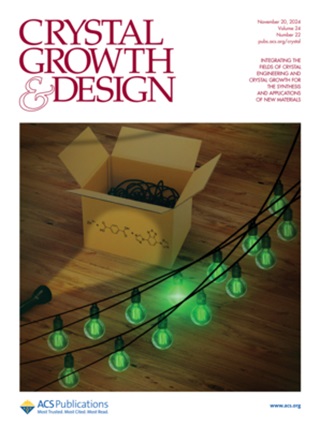杂原子和咬合角对 1,3,4-Thia/Oxadiazole 配体的自旋态和双核铁(II)螺旋体形成的关键作用
IF 3.4
2区 化学
Q2 CHEMISTRY, MULTIDISCIPLINARY
引用次数: 0
摘要
螺旋配合物可在各种应用中充当传感器,通过与特定客体分子结合或对客体分子的存在做出反应来检测客体分子的存在。我们报告了两种新型铁(II)螺旋体和一种单核铁(II)化合物的合成。新配体 LTDA-Hel 如预期般形成了三链螺旋体 [Fe2(LTDA-Hel)3](ClO4)4-3 H2O (C1) 和 [Fe2(LTDA-Hel)3](BF4)4-5H2O (C2),而新配体 LODA-Hel 则形成了带有配位水合副基的单核铁(II)复合物 [Fe(H2O)2(LODA-Hel)2](ClO4)2 (C3)。我们通过单晶 X 射线晶体学对这三种配合物进行了研究,以探讨 O/S 杂原子的大小对螺旋形成的影响。络合物 C1 和 C2 在固态和溶液相中都具有二磁性,溶液核磁共振证实了它们的稳定性。由于螺旋空腔较小,因此使用 VT7Li NMR 光谱测试了 Li+ 离子的客体感应。本文章由计算机程序翻译,如有差异,请以英文原文为准。

Crucial Role of the Heteroatom and Bite Angle Influencing Spin States and Dinuclear Fe(II) Helicate Formation in 1,3,4-Thia/Oxadiazole Ligand
Helical complexes can serve as sensors in various applications, detecting the presence of specific guest molecules by binding to them or responding to their presence. We report the synthesis of two novel iron(II) helicates together with a mononuclear iron(II) compound. The new ligand LTDA-Hel formed the triple-stranded helicates [Fe2(LTDA-Hel)3](ClO4)4·3 H2O (C1) and [Fe2(LTDA-Hel)3](BF4)4·5H2O (C2), as anticipated, whereas the new ligand LODA-Hel formed a mononuclear Fe(II) complex [Fe(H2O)2(LODA-Hel)2](ClO4)2 (C3) with coordinated aqua coligands. All three complexes have been studied by single crystal X-ray crystallography to investigate the effect of the size of the O/S heteroatom in the helix formation. Complexes C1 and C2 are diamagnetic in both solid state and solution phase, with solution NMR confirming their stability. Due to the small helical cavity, guest sensing with Li+ ions was tested using VT7Li NMR spectra.
求助全文
通过发布文献求助,成功后即可免费获取论文全文。
去求助
来源期刊

Crystal Growth & Design
化学-材料科学:综合
CiteScore
6.30
自引率
10.50%
发文量
650
审稿时长
1.9 months
期刊介绍:
The aim of Crystal Growth & Design is to stimulate crossfertilization of knowledge among scientists and engineers working in the fields of crystal growth, crystal engineering, and the industrial application of crystalline materials.
Crystal Growth & Design publishes theoretical and experimental studies of the physical, chemical, and biological phenomena and processes related to the design, growth, and application of crystalline materials. Synergistic approaches originating from different disciplines and technologies and integrating the fields of crystal growth, crystal engineering, intermolecular interactions, and industrial application are encouraged.
 求助内容:
求助内容: 应助结果提醒方式:
应助结果提醒方式:


